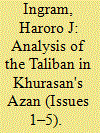| Srl | Item |
| 1 |
ID:
139451


|
|
|
|
|
| Summary/Abstract |
This article analyzes issues 1–5 of the Taliban in Khurasan's Azan magazine. It applies an interpretive framework for analyzing radical narratives, based on a multidisciplinary conceptualization of the radicalization process, to explore how Azan attempts to appeal to its audiences by leveraging ingroup, Other, crisis and solution constructs via value-, crisis-, and dichotomy-reinforcing narratives. Two key findings emerge. First, Azan prioritizes content that empowers its readership toward action with narratives that link ingroup and solution constructs. Second, Azan uses a variety of narrative approaches in order to appeal to a potentially diverse readership at different stages of radicalization.
|
|
|
|
|
|
|
|
|
|
|
|
|
|
|
|
| 2 |
ID:
096147


|
|
|
|
|
| Publication |
2010.
|
| Summary/Abstract |
This article deals with the role of government in encouraging the decline of radical movements. The question posed is: "Which story can the government tell to encourage the decline of radical groups and the disengagement of their members?" The article makes use of the survey of factors promoting decline and disengagement drawn up by Demant, Slootman, Buijs (†) and Tillie in 2008, as well as the factor "official policy strategies" based on concepts taken from discourse analysis, adapted to counterterrorism and deradicalization strategies by De Graaf in 2009. The article will therefore not address the different practical measures in this field, but focus instead on the perception of these official measures by the radicals. It will illustrate this with two case studies: the deradicalization of South Moluccan youths in the 1970s and of jihadist radicals after 2001, both in the Netherlands.
|
|
|
|
|
|
|
|
|
|
|
|
|
|
|
|